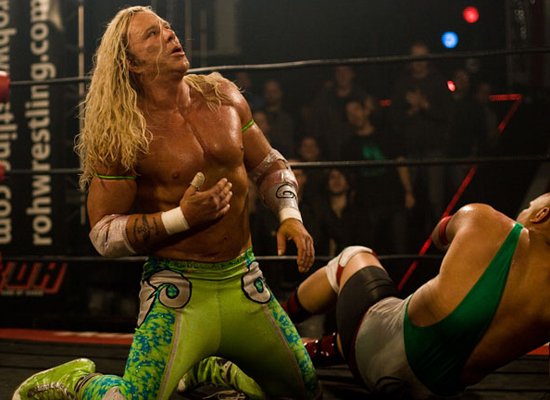
The steroid witch-hunt has expanded beyond athletes in professional sports to include performers in the entertainment industry. The recent government investigation into the pervasive use of anabolic steroids in the scripted entertainment of professional wrestling marks a departure from their focus on steroids in sports. The results of the investigation into steroid use in professional wrestling were conveniently released immediately prior to the nationwide theatrical release of “The Wrestler” promising to capitalize on the heightened media attention given to steroids in wrestling.
A movie about a professional wrestler who uses anabolic steroids that is played by an actor (Mickey Rourke) suspected of steroid use (with a history, marked by multiple physical altercations along with arrests for spousal abuse and resisting arrest, that lends itself to a roid rage interpretation) provides the perfect opportunity for anti-steroid crusaders to target the use of steroids in the entertainment industry.
There will certainly be much discussion about the parallels between Mickey Rourke and his character, Randy “The Ram” Robinson especially when it comes to steroid use. The discussion about Rourke’s physical transformation will remain in the news with every accolade awarded to “The Wrestler” from the recent Golden Globe awards to possible Oscar awards.
Everyone suspects that Mickey Rourke used steroids to obtain the physique seen in “The Wrestler.” The New York Daily News and Men’s Journal do (“Celebrity Side Dish,” January 11).
Mickey Rourke really did those backflips and rope dives in The Wrestler, but probably not without a little help. Though he doubled his daily 80-minute workouts with an Israeli cage fighter and ate seven meals a day, Men’s Journal reports that he most likely took steroids.
When asked, Rourke said: When I’m a wrestler, I behave like a wrestler.
Roger Ebert does (“The Wrestler,” December 23, 2008).
This is Rourke doing astonishing physical acting. He has the physique of a body builder, perhaps thanks to some steroid use, which would also be true of Randy.
Mickey Rourke has already admitted to using anabolic steroids beginning as early as 1995 under the supervision of a physician for testosterone replacement therapy (TRT) (“The Rourke’s Progress,” April 10, 2005).
I never took steroids till I was finished fighting. After I was done boxing. Afterwards I took testosterone shots, because after 34 your testosterone level goes down, and if you’re monitored by a doctor and get a testosterone shot, it’s fine.
Mickey Rourke’s 43 lbs weight gain from 192 lb to very muscular 235lbs over a six month period for the role of Randy “The Ram” Robinson would be suggestive of steroid use for most people as well. But Rourke explains that he has considerable muscle memory from decades of hardcore training at the bodybuilding mecca of Gold’s Venice; his bodybuilding connections and experience were largely responsible for his ability to make such a physical transformation for the movie role (“Mickey Rourke shares how training helped him make a comeback in ‘The Wrestler’,” December 16, 2008).
The bodybuilding of course helped but what a lot of people don’t know and understand is you can’t look like the way I do in 6 months. I have been bodybuilding for 20 years and muscle has memory.
It’s just a matter of how big you want to get or how cut you want to get, and this all depends on the amount of cardio or the diet you are on. We were on a high protein, low carb diet that included 3-4 protein shakes a day. The cardio was very important as well as my ab work during this period of training.
The use of performance enhancing drugs in professional football and baseball focused primarily on the ethical issue of using anabolic steroids, against the rules of the sport, to gain an unfair advantage on the competition. However, the issue of cheating with steroids is irrelevant when it comes to the entertainment industry since it is not a zero-sum game. The justification for a steroid witch-hunt in the entertainment industry will focus on saving the children rather than the issue of cheating. Representative Henry Waxman, in a letter to the Office of the National Drug Control Policy requesting further action by the nation’s drug czar, explains why steroids in professional wrestling (and conceivably the entire entertainment industry) is a national priority.
Over 3 million children and teenagers watch professional wrestling each week. The apparently widespread use of steroids in professional wrestling sends the wrong message to youth.
The government’s investigation into steroids in professional wrestling clearly represents the first attack on the use of anabolic steroids in the entertainment industry. If the feds believe that steroid use in wrestling sends the wrong message to young people, I wonder what type of message the government feels is being sent by actors who use steroids to prepare for roles in Hollywood movie productions? But I can’t imagine the government demanding that Hollywood studios implement steroid testing for actors and actresses?!

About the author
Millard writes about anabolic steroids and performance enhancing drugs and their use and impact in sport and society. He discusses the medical and non-medical uses of anabolic-androgenic steroids while advocating a harm reduction approach to steroid education.

No replies yet
Loading new replies...
Join the full discussion at the MESO-Rx →